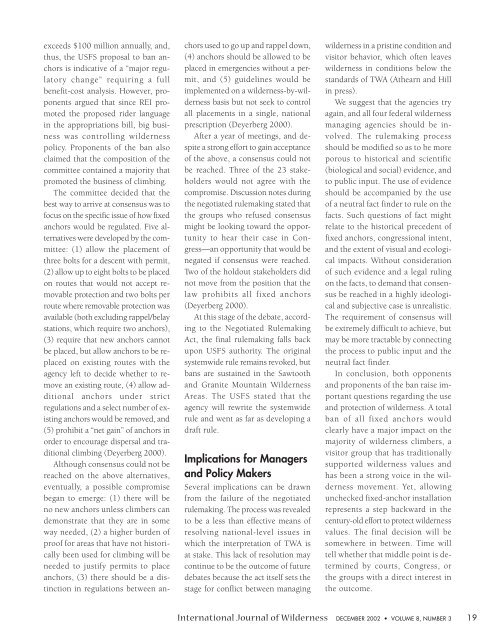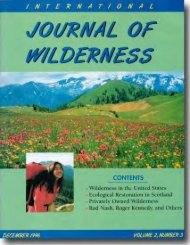Download full PDF - International Journal of Wilderness
Download full PDF - International Journal of Wilderness
Download full PDF - International Journal of Wilderness
Create successful ePaper yourself
Turn your PDF publications into a flip-book with our unique Google optimized e-Paper software.
exceeds $100 million annually, and,<br />
thus, the USFS proposal to ban anchors<br />
is indicative <strong>of</strong> a “major regulatory<br />
change” requiring a <strong>full</strong><br />
benefit-cost analysis. However, proponents<br />
argued that since REI promoted<br />
the proposed rider language<br />
in the appropriations bill, big business<br />
was controlling wilderness<br />
policy. Proponents <strong>of</strong> the ban also<br />
claimed that the composition <strong>of</strong> the<br />
committee contained a majority that<br />
promoted the business <strong>of</strong> climbing.<br />
The committee decided that the<br />
best way to arrive at consensus was to<br />
focus on the specific issue <strong>of</strong> how fixed<br />
anchors would be regulated. Five alternatives<br />
were developed by the committee:<br />
(1) allow the placement <strong>of</strong><br />
three bolts for a descent with permit,<br />
(2) allow up to eight bolts to be placed<br />
on routes that would not accept removable<br />
protection and two bolts per<br />
route where removable protection was<br />
available (both excluding rappel/belay<br />
stations, which require two anchors),<br />
(3) require that new anchors cannot<br />
be placed, but allow anchors to be replaced<br />
on existing routes with the<br />
agency left to decide whether to remove<br />
an existing route, (4) allow additional<br />
anchors under strict<br />
regulations and a select number <strong>of</strong> existing<br />
anchors would be removed, and<br />
(5) prohibit a “net gain” <strong>of</strong> anchors in<br />
order to encourage dispersal and traditional<br />
climbing (Deyerberg 2000).<br />
Although consensus could not be<br />
reached on the above alternatives,<br />
eventually, a possible compromise<br />
began to emerge: (1) there will be<br />
no new anchors unless climbers can<br />
demonstrate that they are in some<br />
way needed, (2) a higher burden <strong>of</strong><br />
pro<strong>of</strong> for areas that have not historically<br />
been used for climbing will be<br />
needed to justify permits to place<br />
anchors, (3) there should be a distinction<br />
in regulations between an-<br />
chors used to go up and rappel down,<br />
(4) anchors should be allowed to be<br />
placed in emergencies without a permit,<br />
and (5) guidelines would be<br />
implemented on a wilderness-by-wilderness<br />
basis but not seek to control<br />
all placements in a single, national<br />
prescription (Deyerberg 2000).<br />
After a year <strong>of</strong> meetings, and despite<br />
a strong effort to gain acceptance<br />
<strong>of</strong> the above, a consensus could not<br />
be reached. Three <strong>of</strong> the 23 stakeholders<br />
would not agree with the<br />
compromise. Discussion notes during<br />
the negotiated rulemaking stated that<br />
the groups who refused consensus<br />
might be looking toward the opportunity<br />
to hear their case in Congress—an<br />
opportunity that would be<br />
negated if consensus were reached.<br />
Two <strong>of</strong> the holdout stakeholders did<br />
not move from the position that the<br />
law prohibits all fixed anchors<br />
(Deyerberg 2000).<br />
At this stage <strong>of</strong> the debate, according<br />
to the Negotiated Rulemaking<br />
Act, the final rulemaking falls back<br />
upon USFS authority. The original<br />
systemwide rule remains revoked, but<br />
bans are sustained in the Sawtooth<br />
and Granite Mountain <strong>Wilderness</strong><br />
Areas. The USFS stated that the<br />
agency will rewrite the systemwide<br />
rule and went as far as developing a<br />
draft rule.<br />
Implications for Managers<br />
and Policy Makers<br />
Several implications can be drawn<br />
from the failure <strong>of</strong> the negotiated<br />
rulemaking. The process was revealed<br />
to be a less than effective means <strong>of</strong><br />
resolving national-level issues in<br />
which the interpretation <strong>of</strong> TWA is<br />
at stake. This lack <strong>of</strong> resolution may<br />
continue to be the outcome <strong>of</strong> future<br />
debates because the act itself sets the<br />
stage for conflict between managing<br />
wilderness in a pristine condition and<br />
visitor behavior, which <strong>of</strong>ten leaves<br />
wilderness in conditions below the<br />
standards <strong>of</strong> TWA (Athearn and Hill<br />
in press).<br />
We suggest that the agencies try<br />
again, and all four federal wilderness<br />
managing agencies should be involved.<br />
The rulemaking process<br />
should be modified so as to be more<br />
porous to historical and scientific<br />
(biological and social) evidence, and<br />
to public input. The use <strong>of</strong> evidence<br />
should be accompanied by the use<br />
<strong>of</strong> a neutral fact finder to rule on the<br />
facts. Such questions <strong>of</strong> fact might<br />
relate to the historical precedent <strong>of</strong><br />
fixed anchors, congressional intent,<br />
and the extent <strong>of</strong> visual and ecological<br />
impacts. Without consideration<br />
<strong>of</strong> such evidence and a legal ruling<br />
on the facts, to demand that consensus<br />
be reached in a highly ideological<br />
and subjective case is unrealistic.<br />
The requirement <strong>of</strong> consensus will<br />
be extremely difficult to achieve, but<br />
may be more tractable by connecting<br />
the process to public input and the<br />
neutral fact finder.<br />
In conclusion, both opponents<br />
and proponents <strong>of</strong> the ban raise important<br />
questions regarding the use<br />
and protection <strong>of</strong> wilderness. A total<br />
ban <strong>of</strong> all fixed anchors would<br />
clearly have a major impact on the<br />
majority <strong>of</strong> wilderness climbers, a<br />
visitor group that has traditionally<br />
supported wilderness values and<br />
has been a strong voice in the wilderness<br />
movement. Yet, allowing<br />
unchecked fixed-anchor installation<br />
represents a step backward in the<br />
century-old effort to protect wilderness<br />
values. The final decision will be<br />
somewhere in between. Time will<br />
tell whether that middle point is determined<br />
by courts, Congress, or<br />
the groups with a direct interest in<br />
the outcome.<br />
<strong>International</strong> <strong>Journal</strong> <strong>of</strong> <strong>Wilderness</strong> DECEMBER 2002 • VOLUME 8, NUMBER 3 19










